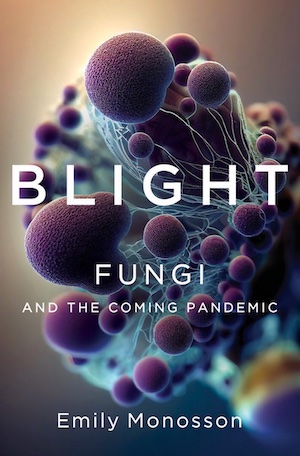By Germaine Cornelissen Guillaume
Winner of the 2024 ΦBK Award in Science
Fungi. The word may first evoke culinary delicacies like mushrooms or critical ingredients in bread, cheese, and alcoholic beverages. It may also bring to mind molds found in bathrooms, kitchens, or basements in the presence of a humid environment. Alexander Fleming’s discovery of penicillin, the first of over 100 antibiotics used today, many of them derived from fungi, also comes to mind. Blight by Emily Monosson, who trained and worked as a toxicologist, is timely since our knowledge of fungi is still incomplete. So, what exactly are fungi?
Historically included in the plant kingdom, all of the about 144,000 known species now form their own kingdom after being separated from plants, since fungi lack chlorophyll and have unique structural and physiological features. As their cells contain membrane-bound organelles and clearly defined nuclei, fungi are eukaryotic organisms. Apart from their cellular structure, fungi distinguish themselves from all other organisms by their nutritional habits and growth patterns. Inconspicuous, they are everywhere, including in our microbiome, being highly resistant to a wide range of environmental conditions and able to thrive in diverse and extreme habitats.
As documented in Monosson’s introductory chapter, a spore can survive for months on the floor of a cave until an opportunity presents itself to hitchhike on a host where it can germinate and begin to grow. Perhaps humans’ best line of defense against fungal diseases is our body temperature since most fungi have an optimal growth temperature of 20° to 30°C; but drawing from experts, Monosson cautions that climate change may pose a challenge if some fungi evolve a higher-temperature tolerance.
While most fungi are harmless and some are helpful, the few that are killers are the focus of this book. As the first example, the author recounts how the Centers for Disease Control and Prevention (CDC) recently flagged Candida auris as a serious global health threat to humans in view of its high resistance to antifungal drugs. Monosson is quick to point out, however, that fungi can devastate other species as well, remarking further that humans largely depend on some of these species, and that often, they are the unwitting enablers. As Monosson draws on the knowledge of many experts throughout her book, she particularly follows the career of Karen Lips, who witnessed firsthand the devastation to Costa Rica’s frogs caused by Batrachochytrium dendrobatidis (Bd).
Turning to the decimation of the whitebark pine trees in the west and of the American chestnut trees in the east, the reader will learn how the fungus Cronartium ribicola, responsible for white pine blister rust, played a major role, together with mountain pine beetles and altered fire regimes, in causing significant mortality of whitebark pine populations in North America. The virtual extinction of the American chestnut, on the other hand, resulted solely from the fungus Cryphonectria parasitica, which killed an estimated three to four billion American chestnut trees.
Other stories of devastation affecting crops, ranging from bananas to rice, wheat, tomatoes, and potatoes, are examples Monosson draws on to discuss important issues related to climate change, increasing populations, and changes in farming that favor the growth of monocultures that lack diversity to fight fungal and other infestations. Similarly, stories such as that of Pseudogymnoascus destructans, which killed bats in droves, bring a discussion of how bats have a well-developed immune system and are notorious for tolerating viruses, making them unique potential vectors, as was likely the case of SARS-CoV-2 and the recent COVID-19 pandemic. It is also an opportunity for the author to explain how inspections and laws emerged for the regulation of the international trade of exotic animals and agricultural products.
Throughout the narrative, boggling statistics bring home the gravity of possible future fungal infestations. The text is interspersed with some interesting historical facts such as the shipment of cherry trees from Japan to Washington, D.C. Their initial unfortunate destruction due to infestation highlighted the need for quarantine measures and led to the passage of the Plant Quarantine Act of 1912. Rules, however, appear difficult to enforce given the vast amounts of plants and animals traveling across continents, with potential dire consequences for humans.
Advances in modern medicine contributed markedly to an increased proportion of the population reaching old ages, at the cost, however, of ever-growing numbers of people at increased risk of infection due to a weakened or compromised immune system. As noted by the author, fungal infections are not only difficult and time-consuming to diagnose, they are also much harder to treat compared with viral or bacterial infections. Contrary to external infections, internal infections can be insidious and deadly. Monosson concludes that we are the direct and indirect cause of disruptions brought about by fungi, and that it is our moral obligation to do whatever we can to prevent the next infestation. She offers some glimpses of hope by citing programs such as using genetic engineering to bring back the majestic American chestnut forest, but the task in this and other cases almost seems unsurmountable without continued governmental support.
Germaine Cornelissen Guillaume is a professor of integrative biology and physiology and Director of the Halberg Chronobiology Center at the University of Minnesota, Twin Cities.




